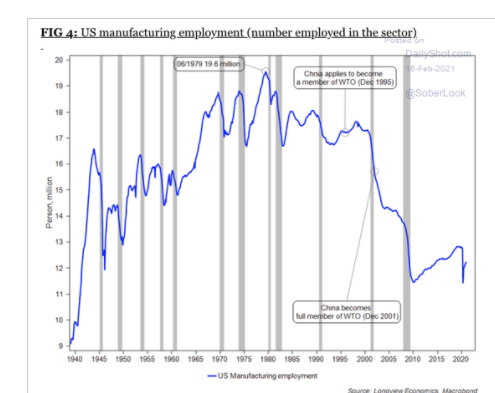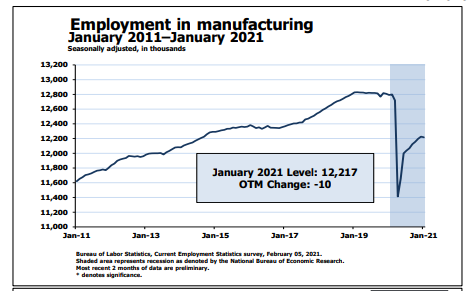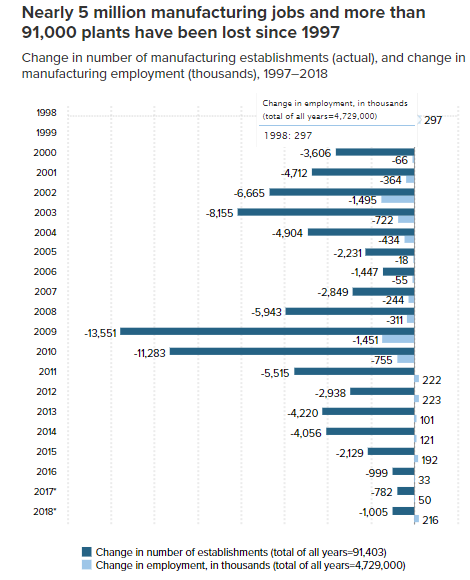Can The Biden Administration Really Restore US Manufacturing Jobs?
“Overall, the U.S. has suffered a net loss of more than 91,000 manufacturing plants and nearly 5 million manufacturing jobs since 1997. Nearly 1,800 factories have disappeared during the Trump administration between 2016 and 2018 (BLS 2020; U.S. Census Bureau 2020a, 2020b). The U.S. has experienced a net loss of manufacturing plants (establishments) in every year from 1998 through 2018 (the most recent year for which data are available).” (Economic Policy Institute, August 10, 2020)
One of the most interesting paradoxes of the last several decades is how the American economy has continued to prosper in the face of a major loss of high-paying manufacturing jobs to China and other low-wage countries.
Indeed, manufacturing employment in the US has collapsed over the past several decades, though the same is not the case with manufacturing production or output. Obviously, manufacturing productivity has continued to increase, and of course, even with fewer employees manufacturing output has continued to grow.
Offshoring, the loss of manufacturing plants, and the massive trade deficit with China are of course symptoms of the loss of manufacturing jobs.
American manufacturing is simply no longer a major job creation engine. In more normal times (excluding the pandemic recession), manufacturing job losses have been more than made up by job gains in other sectors (high tech industries and the services sector.)
But of course, for many local communities which used to rely on have high-paying, manufacturing jobs, the longer-term job losses are very harmful.
Unfortunately, many serious economic and social hardships can be traced to the longer-term loss of manufacturing jobs.
A review of the following charts helps to spell out some of the dimensions of this issue and underscore why even under the welcoming Biden Administration manufacturing jobs are likely not to return.
At first glance, the long-term drop-in manufacturing jobs seem to paint a bleak picture for the health of the manufacturing sector.
The employment share of manufacturing has been declining for more than a half-century. About one-third of all workers held manufacturing jobs after the end of WW2, but this share was down to about 8.6% as of February 2021.
During the worst of the pandemic downturn, the manufacturing sector lost 1.4 million jobs, but as of January 2021, manufacturing had recovered 803,000 of the lost jobs.
After holding fairly steady through the 1990s, the number of manufacturing jobs in the U.S. dropped from over 17 million in 2000 to about 13 million, its pre-pandemic peak level. In fact, over the four Trump Administration, years manufacturing employment actually increased, nonetheless its share of total employment continued to decline.
In output terms, manufacturing's share of real GDP has been fairly constant since the 1940s, ranging between 11.3% and 13.6%. The manufacturing output share stood at about 11% of gross domestic product as of the second quarter of 2019.
Finally, why is manufacturing so important to policymakers and investors? Manufactures account for an exceptionally large proportion of internationally traded goods, and in this trade, the US has been significantly lagging other industrial countries and China.
Moreover, manufacturing is also regarded as a key sector in terms of industrial self-reliance, particularly when shortages of specific items are growing. Research and development spending is also associated with high-tech manufacturing and has many other useful spin-offs. Finally, the jobs provided in manufacturing tend to be high paying and important to many local communities.
So, despite all of the attention to de-industrialization and China grabbing a growing share of US manufacturing potential, the actual level of manufacturing real output has been fairly constant.
Nonetheless, manufacturing’s share of nominal gross domestic product (GDP) has dropped from 28.1 percent in 1953 to just 12 percent in 2015, as seen in the next figure.
In closing, President Joe Biden has recently proposed major investments in infrastructure, climate, and rebuilding the manufacturing sector. His buy America program will likely help domestic manufacturing, but don’t expect a major boom to return, at least not in terms of the number of jobs.
(Click on image to enlarge)

(Click on image to enlarge)

(Click on image to enlarge)





Why is manufacturing important? actually, the answer is obvious: without manufacturing you have no goods to sell. They must be manufactured somewhere, by somebody, even if half the team is robots.
The problem now is that there is such a huge divide between income classes that fewer want to work in manufacturing. The problem is not that manufacturing does not pay well, it is that some other employments pay excessively well.
Do I HAVE AN ACCEPTABLE ANSWER TO THE PROBLEM? NO, I do not have an acceptable answer. The anwer that I do have is unhappy enough to be unacceptable. Oh WEll.